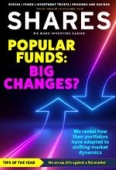Archived article
Please note that tax, investment, pension and ISA rules can change and the information and any views contained in this article may now be inaccurate.
Reasons why investors would pay more to own a particular stock

On 30 May, investment bank Berenberg published a research note on legal group DWF (DWF) saying it should eventually see a ‘significant re-rating’ as the company continued to deliver organic growth with improving margins. At the time, the shares traded on five times forecast earnings for the year to April 2024.
Eight weeks later, Berenberg’s prediction has come true and the shares have gone up more than 50%. The stock now trades on 7.8 times forward earnings.
A re-rating is when investors are prepared to pay a higher multiple of earnings for a stock. DWF’s re-rating was the result of a takeover offer from private equity group Inflexion which spotted an opportunity to buy a company at a cheap price.
Value-style investors seek companies trading for less than they are really worth. While takeovers are one way to crystalise the hidden value, most re-ratings are triggered by other catalysts and are slow to play out.
Herein lies the problem for investors; you need to be patient and recognise what the catalyst might be to drive the re-rating and without one a stock can stay cheap permanently. This is commonly known as a value trap.
Joe Bauernfreund, manager of the AVI Global Trust (AGT), runs an investment strategy based on identifying quality companies trading at a discount. He says: ‘If we own businesses that are growing their profits year in, year out, it allows us to be more patient because the value of that investment is going up itself regardless of whether the discount is narrowing or widening.
‘We are not buying £1 of assets for 70p in the hope that 70p becomes £1. We are buying £1 of assets in the hope that in five years’ time that £1 is worth £2 and the gap in the share price and valuation has narrowed as well.’
Bauernfreund’s position as an institutional investor means he can sometimes put pressure on management teams to make changes (which in turn could drive a re-rating), but retail investors do not have that weight. They need to identify the potential catalysts that would convince more investors to pay a higher multiple of earnings to own the shares.
Price comparison site Moneysupermarket (MONY) is the perfect example of a stock that has undergone a re-rating. In May 2022, Shares highlighted how it should benefit from the cost-of-living crisis as households shopped around for better deals on financial products. At 174p, it traded on 12.6 times forward earnings, a depressed rating because the energy switching market had temporarily shut down, leaving Moneysupermarket without a key source of income.
Today the shares trade at 281.8p with the stock having benefited from two key catalysts. An improvement in earnings pushed up the share price, so too did a re-rating with investors now happy to pay 16.3 times forward earnings.
Factors that can encourage investors to reassess the multiple of earnings they are prepared to pay for a company include results that consistently beat market expectations, consistent market share gains, the disposal of a business unit that had been a drag on the main group, and a more attractive cash flow profile than previously expected. Look for a company that has better prospects than suggested by the equity rating. Find the right one and it could be your ticket to decent returns.
Important information:
These articles are provided by Shares magazine which is published by AJ Bell Media, a part of AJ Bell. Shares is not written by AJ Bell.
Shares is provided for your general information and use and is not a personal recommendation to invest. It is not intended to be relied upon by you in making or not making any investment decisions. The investments referred to in these articles will not be suitable for all investors. If in doubt please seek appropriate independent financial advice.
Investors acting on the information in these articles do so at their own risk and AJ Bell Media and its staff do not accept liability for losses suffered by investors as a result of their investment decisions.
Issue contents
Feature
- Is active fund management a waste of time?
- Popular funds: big changes? We look at 12 widely-held names
- Not all bad news: Here are 10 stocks benefiting from the cost-of-living crisis
- Can emerging markets make the transition away from fossil fuels?
- Emerging markets: technology at the forefront, overtaking developed world on oil consumption
- Our 2023 share picks have absolutely smashed it: up 23% against a flat market
- Gilts are in demand: we explain how to buy and reasons for doing so
Great Ideas
News
- Wildfires and strikes cause investors to worry about airlines and holiday companies
- Unilever flexes its pricing power muscles, but market share losses are a concern
- Ocado’s technology arm gets investors excited again
- Liontrust shares remain in the doldrums as GAM takeover sees new twist
- Revealed: the shares which shone as the FTSE 100 has bumper week

 magazine
magazine








